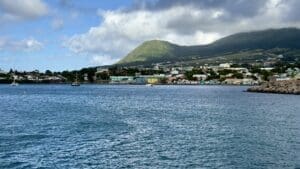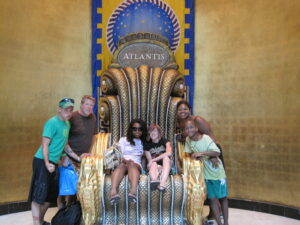Journey Through time, culture, and sustainable travel in Newfoundland , where the raw, untamed beauty meets rich history and heartwarming hospitality. Let’s explore why this island, with its hidden gems and mindful experiences, should be your next travel destination.
“Newfoundland’s dramatic cliffs and pristine waters provide a haven for those seeking both tranquility and excitement.”
— Catherine Duffield
The Welcome Desk
Before we begin let’s stop at The Welcome Desk for “A Closer Look at Whales”
What’s in the name and why visit Newfoundland?
Newfoundland, located on the east coast of Canada, was named by English explorers. The name literally means “new found land.” John Cabot, an Italian navigator under the commission of Henry VII of England, is credited with discovering the area in 1497. He referred to the new territory along the Atlantic as “New Found Launde,” which evolved into Newfoundland. The name reflects the fact that it was a new discovery for Europeans. Newfoundland is a world apart, offering a perfect escape from the hustle and bustle of modern life. The dramatic coastline, quaint fishing villages, and endless horizons will invigorate your senses and provide a tranquil backdrop for mindful exploration.
A Dive into History
Newfoundland is steeped in history. From the UNESCO World Heritage site of L’Anse aux Meadows, the remnants of a Norse settlement dating back to 1000 AD, to the colorful houses of St. John’s, the oldest city in North America, history buffs will find plenty to explore.
The indigenous peoples of Newfoundland primarily include the Beothuk and the Mi’kmaq.
Beothuk
The Beothuk were the original inhabitants of Newfoundland, having lived there for thousands of years before European contact. Primarily a coastal people, they relied on fishing, hunting, and gathering. Additionally, they also ventured inland to hunt caribou.
Culture and Social Structure: The Beothuk painted their bodies, tools, and dwellings with red ochre, which became a distinct cultural marker. They lived in wigwams and used conical summer houses called “mamateeks”.
The Beothuk population dwindled due to factors such as violence, displacement, and diseases brought by Europeans. Consequently, the last known Beothuk, Shanawdithit, died in 1829, marking the tragic extinction of their culture.
Mi’kmaq
Origins and Territory: The Mi’kmaq primarily lived in the southern and western parts of the island. They used birchbark canoes for transportation and built wigwams for shelter.
Lifestyle: The Mi’kmaq were semi-nomadic, moving seasonally to hunt, fish, and gather resources. They used birchbark canoes for transportation and built wigwams for shelter.
Cultural Practices: The Mi’kmaq used wampum (shell beads) for ceremonial and diplomatic purposes. Their social structure was organized into bands led by a chief (sagamore).
European Contact and Adaptation: The Mi’kmaq initially engaged in trade and peaceful interactions with European settlers. The arrival of Europeans led to changes in their traditional lifestyle, as they integrated new tools and goods.
Many Mi’kmaq people continue to live in Newfoundland, especially in the Conne River area. They actively preserve and promote their cultural heritage through celebrations, crafts, and education. Meanwhile, the history of the indigenous peoples of Newfoundland is one of resilience and adaptation. As a result, they have a rich cultural heritage that continues to be acknowledged and celebrated today.
Highlights & Hidden Gems
Nature and Wildlife Wonders
- Witless Bay Ecological Reserve: For an unforgettable, budget-friendly experience, hop on a boat to witness puffins and humpback whales in their natural habitat.
- Gros Morne National Park: A UNESCO World Heritage site, perfect for hiking, kayaking, and soaking in the natural beauty. The Tablelands offer a glimpse into Earth’s mantle, promoting a truly unique mindfulness experience. Visit my IG page for more detail on Gros Morne and don’t forget to follow for more travel insights.
Charming Towns and Historical Experiences
- Elliston: Known as the Root Cellar Capital of the World, explore historic root cellars and see puffins up close.
- Trinity: A picturesque town with beautifully preserved historic buildings and great hiking trails.
- La Manche Provincial Park: Fabulous suspension bridge and coastal trails with stunning views.
- Dildo Yes, it’s real! A quaint town with a funny name and beautiful harbor views.
Fargo Island: A Serene Retreat
- Fogo Island: Off the beaten path, Fogo Island is a serene haven known for its stunning landscapes and traditional fishing communities. Stay at the eco-friendly Fogo Island Inn, built with sustainability and local culture in mind.
Coastal Beauty and Maritime Heritage
- Harbour Breton: Gorgeous, off-the-beaten-path location with a rich maritime history.
- Sandbanks Provincial Park: Sandy beaches and dunes, perfect for a quiet day out.
- Twillingate: Visit during iceberg season for some spectacular views. Iceberg season typically occurs from late May to early June. This is the best time to see icebergs floating along the coast as they drift down from the Arctic.
- Cape Spear: The easternmost point in North America with a historic lighthouse and stunning vistas.









*This blog post contains affiliate links for Expedia, Sunny Daze, Western Rise, and Yellow Leaf Hammock. I may earn a commission for qualifying purchases at no additional cost to you. My recommendations are based on my own experiences and research, and I only suggest products and services that I truly believe will add value to your life. Your support helps me continue to provide high-quality content on this blog. Thank you for your support!
Culinary Delights & Cultural Experiences
Savor Newfoundland’s rich culinary heritage with a modern twist at these sustainable dining spots:
- Mallard Cottage: Located in Quidi Vidi Village, this restaurant combines traditional Newfoundland dishes with local, seasonal ingredients in a historic setting.
- The Merchant Tavern – Offers a menu focused on fresh, local ingredients with innovative dishes.
- The Reluctant Chef – Known for its commitment to sustainable practices and locally sourced ingredients.
- Chinched Bistro – Provides a farm-to-table dining experience with a focus on local produce and house-made charcuterie.
Newfoundland offers a variety of rich cultural experiences:
Cultural Hubs and History in the Capital: St. Johns
- The Rooms – A cultural hub in St. John’s, combining a museum, art gallery, and archives to tell the story of Newfoundland and Labrador’s history.
- The LSPU Hall – Located in St. John’s, this theatre is a space for contemporary theater productions and music, often highlighting local talents.
- Signal Hill National Historic Site – Famous for its military history and as the site of the first transatlantic wireless communication by Guglielmo Marconi.
- Quidi Vidi Village Plantation – An artisan studio and cultural hub where you can meet craft makers and see traditional Newfoundland crafts being created.
Heritage and Nature Escapades
- Gros Morne Theatre Festival – An annual festival in Cow Head featuring plays and performances that highlight Newfoundland’s heritage and stories.
- Elliston Root Cellars and Puffin Viewing Site – Elliston is known as the “Root Cellar Capital of the World,” and it offers a glimpse into historic food storage methods. It’s also a prime location for viewing puffins.
- Battle Harbour – An island community and National Historic District that offers a glimpse into traditional Newfoundland life and the fishing industry’s history.
Maritime and Culinary Adventures
- The Fisheries and Marine Institute of Memorial University – Offers hands-on experiences and tours related to the fishing and maritime heritage of Newfoundland.
- Newfoundland Chocolate Company – Take a guided tour to learn about the craft of chocolate-making with a unique Newfoundland twist.
Iconic Natural and Historic Sites
- Cape Spear National Historic Site – Visit the easternmost point in North America and explore the historic lighthouse while soaking in panoramic ocean views.
Mindful Shopping
Visit Gros Morne – Festivals and Events
For treasures to promote mindfulness at home, visit The Craft Council Shop in St. John’s. Here, you’ll find handcrafted pottery, textiles, and woodwork by local artisans. A must-visit for sustainable travel in Newfoundland is The Newfoundland Weavery (St. John’s) which Offers a wide range of handmade items including woolens, carvings, and local art pieces.
Mindfulness & Wellness Activities
Megan Humphrey Yoga: “MHY curates special events, local retreats and unique experiences in partnership with other local businesses and avails of any opportunity to showcase the unique beauty of the west coast of Newfoundland as a backdrop to practice yoga and mindfulness.”
Meditation Walks: Explore the East Coast Trail, where you can immerse yourself in nature and practice mindfulness through walking meditation. Make sure you’re prepared with a sustainable wardrobe from Western Rise.
If you’re a hiking, backpacking, camping, snowshoeing or hunting lover, click on over to Where My Boots Have Been. I don’t believe you will find a more intimate and beautiful first hand introduction to sustainable travel in Newfoundland. After browsing this site, I don’t believe I’m even scratching the surface.
*Portable Yellow Leaf Hammock: Elevate your relaxation by bringing a portable yellow leaf hammock on your adventures. Whether you’re lounging by the shore or in a serene forest, this hammock offers a perfect, meditative space to unwind and connect with nature.
Travel Ready: As you prepare for your sustainable travel in Newfound, consider outfitting yourself with sustainable and versatile clothing from *Western Rise. Known for their high-performance, eco-friendly apparel, Western Rise ensures you’re ready for any adventure, whether you’re trekking through forests or navigating urban landscapes. Enjoy 15% off your entire order with the code LiveThriveTravel. Limited to one use per customer. Discover the perfect blend of comfort, style, and sustainability at westernrise.com.
Eco-Friendly Travel Tips
Sustainable Accommodations: Choose eco-friendly lodgings like Artisan Inn in Trinity, which emphasizes sustainability and local culture.
Twillingate & Beyond: “A small family operated business that offers boutique accommodations, Artisan Market & Cafe and experiences on the oceans edge, centrally located in downtown Twillingate, Newfoundland and Labrador. Rejuvenate and unwind in our seaside getaways with a range of packages that are bound to bring you rest, joy and adventure.”
Local Transportation: Opt for biking or walking tours to reduce your carbon footprint and immerse yourself in the local environment.
Support Local: Whenever possible, support local farmers’ markets, artisans, and restaurants that prioritize sustainability.
Conclusion
A trip to Newfoundland is more than just a vacation; it’s an opportunity to live well, thrive mindfully, and travel with purpose. With a variety of activities to suit every budget and a strong emphasis on eco-friendly practices, Newfoundland invites you to reconnect with nature, history, and yourself. Ready to embark on a journey that enriches your life and supports the local community? Newfoundland awaits.



